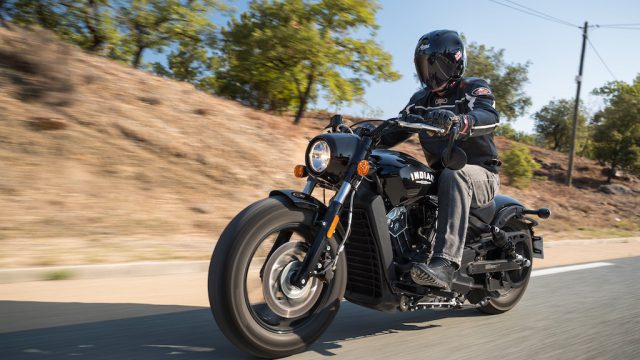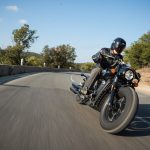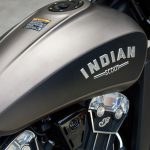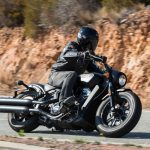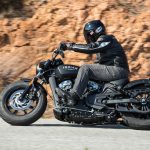First European ride in the south of France’s Cote d’Azur on the latest variant of Indian’s middleweight V-twin model range, the Scout Bobber
With the demise of Victory earlier this year, Polaris Group’s now standalone Indian motorcycle brand has come late to the party at the Bobber bash, with the new-for-2018 blacked-out lowrider version of its midsize Scout model platform which carries that name, only now reaching dealers around the world. But Indian surely hopes to be better late than never in expanding its Scout troop to capture an ironically more youthful customer corps than the many thousands who’ve so far bought this best-selling model with its liquid-cooled 1133cc/69ci 60º V-twin eight-valve engine, since making its debut in 2015 – followed by the first iteration of that platform, the entry-level Scout 60 with smaller 999cc/61ci motor launched last year. .

Ironic, because to attract the Millennial mob representing its target audience for this new lowrider model, Indian has gone back to the future in seeking to encapsulate the spirit and ethos of a type of biking that had gone out of fashion by the time said audience’s parents were born, let alone they themselves. For those not yet up to speed with this iconic – yes, it’s a fair use of the term – piece of two-wheeled Americana, the Bobber was the forerunner of today’s Custom bikes, initially concocted in the late Forties and early Fifties by GI’s returning home from war, complete with stacks of saved-up Army pay they wanted to spend on a bike. The lack of new product from H-D and Indian, whose production facilities were worn out by the ravages of flat-out production to meet the demands of the war effort, meant that they had to buy used – so they did, and then modified the result to get more speed, as well as greater allure, often going racing with the result.
Read More:
KTM 790 Duke Prototype road test – filling the gap
Akrapovic Full Moon custom: Full Moon rising

To do so, the Bobber boys invariably used a Harley-Davidson or Indian as the basis – but as more and more war veterans were demobbed, the massive shortage of even second-hand civilian machines sent prices skywards, leading them instead to acquire now-unwanted military dispatch bikes which they then ‘bobbed’ by cutting back the rear fender (aka mudguard) – hence the term ‘bobtail’ – as well as stripping off other unwanted parts to make the result as light as possible for dirt tracking or, especially, street racing. Going from a dead stop to flat out as fast as possible was the bobber’s modus operandi, as practiced in the illegal street drags staged throughout the USA back in the ‘50s – American Graffiti, anyone?. There were plenty of unfinished freeways comprising Eisenhower’s fledgling Interstate Highway System where you could drag race pretty safely – often for big money in side bets – before said freeways got completed, and the cops who had previously left them to get on with it moved in to shut down the now illegal sport. That led to drag racing getting commercialised, as privately-owned drag strips got built by promoters eager to take it off the streets and into venues where they could make money from it. A Bobber thus represented a minimalist approach to bike building that was made for go, not show, hence anything that didn’t constitute a necessity was deleted.

The Bobber later mutated into the Chopper in the Sixties – though it’s worth noting that in today’s America the garish, raked-out custom Choppers that were all the rage a decade ago before the advent of sub-prime mortgages, are now so very yesterday. The clone manufacturers who built them have now mostly gone to the wall, leaving the more minimalist and far more rideable Bobber-style Customs to enjoy a resurgence. Hence one of Harley’s recent best-sellers has been the Bobber-style Forty Eight, not to mention its well-priced Indian-made (as, in India, not by Indian!) 750 Street Rod, and while the Moto Guzzi V9 Bobber and Yamaha XV950 Bolt have both done well, the massive success of Triumph’s authentically styled new Bonneville Bobber launched a year ago must have really fuelled Indian’s focus on this so-cool segment of the streetrod sector. With 6,000 bikes sold up to the end of August, the Bobber is Triumph’s fastest-selling model ever, an accolade that Indian is surely hoping at least to match with its version of the Bobber concept.

However, unlike the authentically-styled Triumph which screams ‘Bobtail’ at you aesthetically as soon as you lay eyes on it, its Indian counterpart is much more restrained – low key, almost. Thanks to the bulky and definitely unlovely stock rear numberplate holder fitted to Euro-compliant bikes and reaching back behind the cutdown rear mudguard, it doesn’t even look particularly well bobbed unless you go shopping in Indian’s voluminous aftermarket catalogue, and fit the side-mounted licence-plate holder that comes as stock in the US of A.. It’s more of a stripped-down single-seat Custom coming from the dark side, though it’s not particularly any the worse for that. Just that the term ‘bobber’ used to be applied to a very definite type of motorcycle that kickstarted the post-WW2 Custom bike culture, whereas nowadays it’s just a designation that manufacturers attach to a model to broaden its clientele – the term Scrambler is heading the same way, down the same road that Café Racer once followed. So, is this variation of the Indian Scout really a Bobber? No, not really. Is it a cool-looking variant of the chunkier-styled stock Scout, minus the chrome? Absolutely.
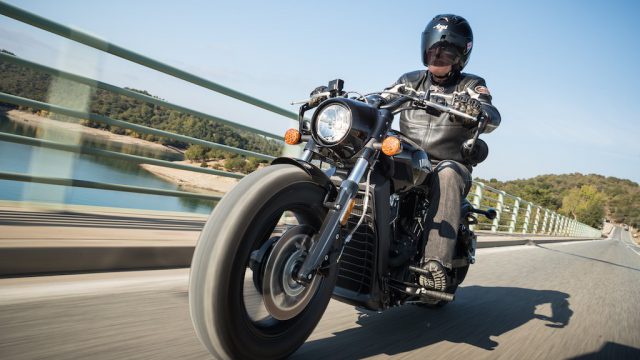
To achieve this, Indian’s 31-strong design team led by ex-Fiat and BMW stylist Greg Brew, who’s the Director of Industrial Design at Polaris Industries, took a scalpel to the stock Scout in search of a darker, more muscular appearance obtained by stripping away any frills and going light – or dark! – on chrome. So essentially, almost everything on the original Scout that was previously painted silver, chromed or made in polished alloy has gone black on the Bobber variant, including the tubular steel frame and hefty chassis castings, the long twin-stack exhaust silencers and headers, both 16-inch cast alloy wheels, the fork sliders and tripleclamps, the radiator shroud, the laydown Showa shocks and coil-over springs plus the swingarm they’re mounted on, the entire engine except for the welcome contrast of the bare alloy cylinder head covers and cylinder ribbing, the taper-section one-piece handlebar and grips, the footpegs, rear brake and gear levers, the clutch cover, ignition cover and headlight nacelle, the drive belt and all its related hardware including the large front pulley cover, and the 12.3-litre fuel tank carrying a new Indian badge with the name in a different font, plus both mudguards on the two black models – glossy and matte – I rode at the European press launch based in Cannes, in the sunny south of France. There’s also a black speedometer face instead of the usual red and cream on the stock Scout. Phew! That’s a lot of black, Polaris.

Still, going dark obviously does make for a moodier-looking motorcycle than the chromed-out stock Scout [see photos], and that’s really the whole point of the exercise in creating a bike whose minimalistic style embodies touches of drag racer and flat tracker worked into its design. This is a styled-up Scout special, not really an outright new model, and it’s available in a choice of five colours – red, glossy black and matte black, Silver Smoke and Bronze Smoke – for £11,299 in the UK incl. 20% tax. That makes it the costliest of the so-called Bobber bikes now available in the marketplace, with the Triumph that’s the class benchmark retailing at £10,660, the Harley Forty-Eight at £9,995, the Moto Guzzi V9 Bobber at £9,002, and the Yamaha XV950 at a bargain-priced £8,399. It’s a pity that at that premium price the Indian’s brake and clutch levers should be non-adjustable, while the bar-end mirrors fitted to the test bike are in fact options in Europe (though stock in America). Having them underslung beneath the handlebar grips as on the test bikes is dangerously useless if allegedly cool-looking, but if you really want to see what’s behind you, they can be reversed to sit above the ‘bar ends. The stock mirrors come mounted in the conventional position inboard of the grips – check out the studio photos to see what these look like. Worth noting however that all the lights on the Scout Bobber are LEDs, including the self-cancelling direction signals, which is a nice touch.
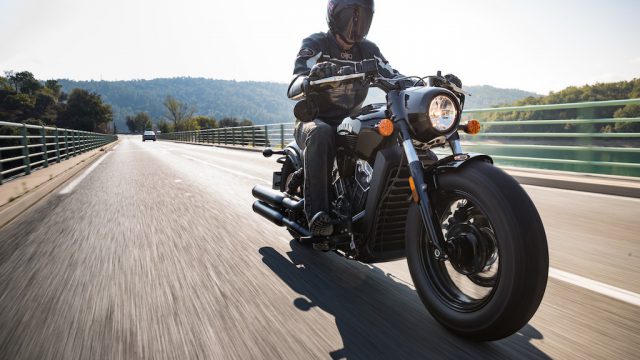
The six-speed liquid-cooled 60º V-twin motor measuring 99 x 73.6 mm for 1133cc powering the stock Scout is completely unchanged for use in the Scout Bobber, developing a claimed 94 bhp/70 kW at 8,000 rpm in Euro 4 compliant guise, with torque peaking at 5,800 rpm where 97 Nm/9.89 kgm/71.54 ft-lb is on tap from what in spite of those revvy dimensions is a pretty meaty motor. Add in almost supernaturally well mapped fuelling, with a liquid-smooth pickup from a closed throttle, and this makes for an engine package that’s a delight to use, whether pootling round town trying to avoid getting overrun by an Italian wedding party’s array of exuberantly driven Fiat Abarth 500s that had taken over downtown Cannes for the afternoon, or getting it on good and hard in the glorious riding roads leading into the hills behind the Cote d’Azur.

The Indian’s buttery-smooth gearchange and light-action clutch make it easy to always be in the right gear at the right time on the Scout Bobber, but the real surprise came after switching to the revcounter reading in the digital panel set into the analogue speedo, and discovering that the Indian pulled strong and hard from as low as 2,500 rpm, with nary a hiccup all the way to the 8,500 rpm limiter, and minimal vibration other than a pleasant subdued thrum through the footrests. Equally subdued, however, is the sound issuing from those twin stacked silencer cans, which is so muted as to be practically non-existent – and even the slash-cut Remus performance exhaust that one of the bikes in our group was carrying didn’t sound a whole lot louder. Pity. Still, this is a superlative powerplant that’s frankly more European than American in nature, making it no surprise to discover it was developed in Switzerland by Polaris Corp’s wholly-owned subsidiary Swissauto, which also concocted Indian’s FTR750 flat-tracker that’s just blitzed Harley and Kawasaki to dominate the 2017 AFT/American Flat Track series on the historic marque’s return to racing. Inevitably, the next variant on the Scout platform will indeed be a Street Tracker paying homage to the FTR750’s AFT dominance…!

So, ten out of ten for performance and character as far as the Scout Bobber’s engine package goes – but sadly the rest of the bike is more of a compromise, dictated by the need for it to appear cool. To obtain those hunkered-down hotrod looks Indian’s stylists have lowered the rear end and reduced the stock Scout’s rear suspension travel by one-third, from an already hard-assed 78mm to a mere 51mm on the Bobber. They’ve also created a far more aggressive riding position by fitting a much flatter street tracker-style handlebar to replace the Scout’s more pulled-back equivalent, while at the same time moving the footrests 38mm closer to the rider, and paradoxically increasing the seat height slightly, from 643mm on the stock Scout to 649mm on the Bobber, thanks to the reshaped two-tone leather seat that’s better padded than the stocker’s.

What this means is that while the low-slung stance will allow riders of almost any height to put both feet flat on the ground at rest, for a 5’10”/1.80m rider the riding position feels slightly curious at first, though you do eventually get used to it, on the needs-must basis. The seat is well enough padded to avoid it delivering numb-bum syndrome, but while your upper body leans forward to let you grasp the wide, flat handlebar, your feet are pulled back towards you in a slightly unnatural position, so that you’re more stretched out up top, but your legs are more cramped down below. It’s not nearly as bad as Harley’s downright unsatisfactory Street Rod stance, but it’s not ideal, and you can’t help wishing that the footrests were mounted even further rearwards for a more natural stance that doesn’t fold the rider in half – an option which doesn’t exist because of the lower exhaust pipe getting in the way if you were to move the rearsets further – well, rearwards. What essentially happens is that you end up leaning forward over the fuel tank into the wind in a more aggressive stance that at least has the side benefit of loading up the front wheel better with your body weight. Call it sportbike ergos in a cruiser context – a real blend of opposites that you do get used to in the end. The sidestand is super-functional, by the way – easy to access with your left toe, and the Indian is very stable sitting on it. It’s a lesson to other manufacturers on how to do this.

Though the fat Taiwanese-made Kenda K791 150/80-16 rear tyre does restore a little bit of the missing suspension travel when you ride the Bobber – expect Indian Bobber owners to lower the air pressure on this to get extra flex for a more comfy ride – the reduced compliance of the twin rear gas shocks that aren’t even adjustable for the preload of their progressive rate springs, makes you plot a course to avoid running over manhole covers in city streets where the rear suspension will easily bottom out, as well as over any cobblestones, repair patches or other such road rash any place you encounter this, if at all possible. I’m used to riding Classic bikes with relatively primitive suspension by modern standards, but the Scout Bobber’s rear end isn’t as compliant as the old twin-shock Marzocchis fitted to my 1967 Benelli Tornado 650cc parallel-twin, which are moreover adjustable for spring preload. Does this mean Indian only expects its Scout Bobber customers to profile around town at low speeds, preferably on billiard-table smooth streets?

This emphasis on style over substance is a real pity, because the new Indian actually handles and steers quite well – actually, very well by Custom bike standards. The non-adjustable Showa fork offers the same 120mm of wheel travel as on the stock Scout, but that bike’s twin-rate internal springing has been replaced here by a new cartridge design for better compliance, and this is right on the money, with excellent settings that bely the new bike’s ultra-rangy cruiser-esque steering geometry, with a hefty 29º of fork rake and massive 120mm of trail on a bike with a rangy 1562mm wheelbase. Somewhat improbably, the bulbous 130/90-16 front Kenda transmits excellent feedback through the fork, with the result that in riding the Bobber as hard as that fabulous engine undoubtedly encourages you to do, you have a great sense of control. This encourages you to chuck the Bobber into a fast, sweeping turn secure in the knowledge that the front end will stick well, and you can keep up turn speed to an unlikely extent for the kind of bike this is. The single 298mm front disc gripped by a two-piston Nissin caliper is adequate without being exceptional in stopping a bike weighing 245kg dry, or 255kg tanked up and ready to rock – though you do have to use the similar-size rear brake gripped by a single-piston caliper pretty hard as well for an emergency stop.

The only problem with riding the Bobber like the urban café racer it really is, is that Indian has sacrificed ground clearance by reducing rear suspension travel and thus ride height in pursuit of the lowboy look. Reducing maximum lean angle from 31º to 29º may not sound much, but it’s immediately noticeable when you crank the Bobber into the most gentle of turns, and find yourself scraping the long/wide footrests quite hard – as well as your boot heels if you don’t tiptoe on the footpegs. Ignore that, and the next thing to touch down is the much more substantial lower exhaust header on the right – all the bikes in our riding group had the outer skin of the double-skinned exhaust scraped right away. We can only dream at this stage of a modern Sport Scout just like the model which dominated the early days of American Class C racing, including winning the inaugural Daytona 200 in 1937 – complete in 21st century mode with a raised 2-1 exhaust, lifted rear end with longer shocks, rearset foot controls with shorter footrests, and more sporty steering geometry. Indian engineers, take notice: your superlative Scout engine package demands it, guys…

Meantime, until that happens the Scout Bobber is just a stylebike supreme, more focused on form than on function, but one that in keeping with Indian’s growing reputation for delivering motorcycles that handle well and have great engines, is indeed fun to ride. You just can’t help feeling that it could have been quite a bit better if the Polaris styling squad hadn’t decided to sacrifice rear suspension compliance in pursuit of a hard-assed look.

Indian Motorcycle’s International Product Manager, Ben Lindaman explained why they did so at the Cannes launch. “We’ve introduced the Scout Bobber to bring some edge to Indian,” he said. “‘Strip it down’ was the inspiration Indian Motorcycle used when developing this bike, because many Scout riders have already been bobbing their bikes to give them an aggressive and raw-edged look. The Scout Bobber is inspired by those owners, and this new model will offer a great platform for even more personalisation.” Indeed so, with that fat aftermarket catalogue not only listing the Remus exhaust, but also stuff like wire wheels, a 1920s-style springer seat, a passenger seat pad and footpegs – one reason the rear mudguard isn’t cut back TOO far – a 16in Ape handlebar kit, a tank pouch, saddlebags, luggage rack and rack bag, etc. etc. “We don’t expect too many Scout Bobbers to remain stock, as delivered,” says Lindaman. “It’s going to be a fruitful basis for personalisation and customisation, especially at that price level.” Can’t argue with that – in which case, perhaps it does merit the Bobber name, after all….!

